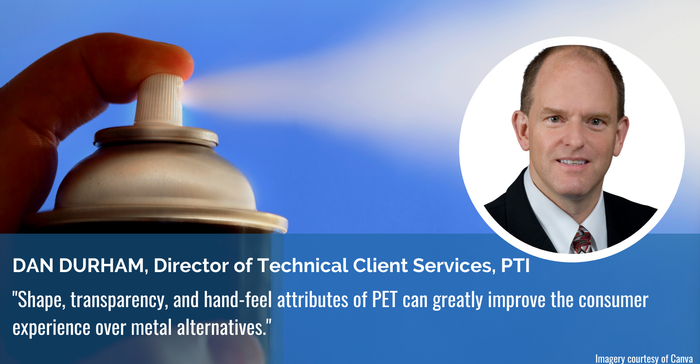Metal-based aerosol cans can expect healthy competition from PET alternatives that offer molding and consumer advantages.
August 30, 2021

A well-known driving force behind packaging innovation is commercializing something that will help a product stand out on the shelf. To further that discussion, let’s look at aerosol containers.
A vast majority of products dispensed via aerosol are in metal cans. It’s a packaging type that has resisted interlopers longer than most other categories. Perhaps now is the right time to consider plastic-based aerosol containers for a broad variety of applications including shaving gels, sunscreen, cooking oil, cleaning products, air fresheners, and more.
The plastic that quickly rises to the top of this discussion is PET, although others could theoretically be considered, as well.
With an ability to be blowmolded into shapes with ergonomic attributes and marketing appeal, PET is adaptable to the application. For those brand owners who want to commercialize packages that can become iconic, PET is a solid consideration.

Shape, transparency, and hand-feel attributes of PET can greatly improve the consumer experience over metal alternatives. Because PET doesn’t leave behind a “rust ring” when the base has been in contact with moisture, consumers no longer need to deal with surface cleaning where spray bottles have been placed.
Improvements in processing technologies also create a path forward. The key is to create a container that has the strength to withstand the pressure of the propellant, while also providing enough barrier to deliver the shelf-life attributes required by the product.
Consideration also needs to be given to container stress crack, drop impact, and burst resistance to ensure proper performance. Optimizing the bottle and preform design as well as the injection and blowmolding processes are critical to meet the desired criteria. State-of-the-art injection and stretch/blowmolding machines make it easier now than in the past to obtain the desired properties.
Drilling down deeper.
It’s important to mold high quality preforms, with low IV loss and pristine injection-gate vestige. Those preforms then must be blow molded into containers with optimized material distribution and level of molecular orientation necessary to achieve the required performance. Developments in compression and injection-compression technology for PET preforms will further enable using high IV materials and produce higher quality gates.
Providing guidance for plastic aerosol packaging and supporting the growth of the aerosol industry are organizations such as the Household & Commercial Product Association’s Plastic Aerosol Research Group (PARG) in the US and European Aerosol Federation (FEA) in Europe. They are international consortiums working with brands and converters as well as government bodies.
PARG, for instance, created and maintains a manual of voluntary test methods that converters and brands can use to guide their package development and production. These methods mimic, in many ways, those used by the beverage industry, but with special considerations for the aerosol industry and the use of valves and propellants.
PARG also develops fire test matrices and collects data to support Department of Transportation (DOT) code change. It works with the industry on regulations that permit plastic aerosol transportation and warehousing.
With a growing number of brands wanting to launch new aerosol products and offer new experiences to their consumers, we are sure to see a growing number of offerings from the packaging converters for both dip tube and bag-on-valve plastic aerosol containers.
Author: Dan Durham is the director of technical client services at PTI. He has decades of experience in plastic packaging ranging from design to injection and blow molding processing. He currently focuses his efforts on helping multinational brand owners successfully navigate packaging projects from concept to commercialization and supporting their sustainability goals.
About PTI
PTI is recognized worldwide as the preferred source for preform and package design, package development, rapid prototyping, pre-production prototyping, and material evaluation engineering for the plastic packaging industry. For more information: www.pti-usa.com.
About the Author(s)
You May Also Like




